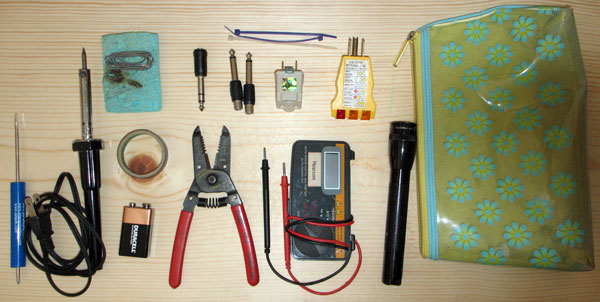I just got word that the online service Stikkit from Values of n is closing (along with the related I Want Sandy service). I hadn’t used Stikkit for over a year, so discontinuing the service won’t have any immediate impact on my online life. But I’m sad to see it go because it was such an elegant piece of software. Stikkit was the first browser-based application that really felt like an app to me and not just a kludgy hodgepodge of javascript. The good news is that the developer is now working for Twitter–let’s hope more innovative, usable software is in the works.
Tag Archives: Tools
Max 5 First Impressions
Over the last few days I’ve begun to dig into Cycling 74’s Max 5. Here are my first impressions of the update. I haven’t yet performed with this version of the program or used it to run an installation, so I don’t have any information about stability or performance.
First the obvious change: the interface is bright and shiny–definitely not the clunky old Max look. I can’t say I’m immediately in love with it, but I do believe by the time I tweak the default settings a little I’ll be quite comfortable with the new look. I very much appreciate the options for changing the appearance of objects (even though some inspector windows are daunting when you first open them).
I love the usability features of Max 5:
• the search function
• the ability to double-click on a message in the Max window and be taken immediately to the part of the patch the message pertains to
• the keyboard shortcuts (damn, it’s so easy to get used to typing ‘n’ or ‘c’ or ‘m’ or ‘t’ or ‘b’ and having an object just show up). I suspect I’ll rarely use the gussied-up new object palette since the keystrokes are so convenient.
• support for long filenames (it’s the little things, really. OK, it’s the little, long things.)
I also love the new timing options, though I haven’t had a chance to use them extensively. I’m looking forward to creating polyrhythmic mayhem using a few transport objects all running at different tempi.
I like the idea of presentation mode, I just haven’t actually implemented it. I’ve always done something similar anyway: create a separate subpatch for just the controls I need, and since presentation mode only seems workable in a single subpatch I suspect it won’t radically change my workflow. Presentation mode would be more useful for me if any object in any subpatcher could be added to the presentation mode of a particular window. But that already sounds too complicated to manage (which object? in which subpatch? to which window?), plus the this is already possible using standard Max objects like send and receive.
I have mixed-feelings about the integrated documentation. I like the convenience of having help always at your fingertips but miss the portability of a pdf file. If you’re not running max, it’s tricky to get to the documentation. (Of course, you can always go to the Cycling 74 site.)
I’ve had a harder time with file-path issues and object conflicts in Max 5 than with other upgrades. This is likely just me and my convoluted setup. I have a bad habit of downloading almost every third-party Max object and freeware VST–not that I use them all. In fact, upgrades are often the times I evaluate the third-party objects that are essential to my work. The short list: LObjects, LitterPro, fiddle~, and a handful of others.
I’m looking forward to getting deeper into Max 5.
Flight path finder
Here’s my latest web 2.0-a-riffic, GoogleMaps, GPS, mashup thingamabob idea: a website that allows users to view common flightpaths for a particular location and evaluates the location based on frequency of flyovers and noise level. Would be a great tool for noise-sensitive home buyers. Or for flyover collectors, plane spotters, etc.
Gig Survival Kit
I ran across this very sleek Electronic Musician Emergency Adapter Kit and it inspired me to post my own Gig Survival Kit. I used to carry a similar collection of adapters, but now I only carry a few adapters augmented by a set of tools.
From left to right and top to bottom:
- combination phillips and flat head screwdriver
- soldering iron
- sponge and solder
- electrical tape
- spare battery (for Basic Stamp)
- stereo 1/4″ to 1/8″ adapter (headphone adapter)
- wire cutter and stripper
- wire ties
- (2) RCA to 1/4″ adapters
- ground lifter (lifesaving hum remover)
- multimeter
- outlet tester
- flashlight
- tres chic cosmetic bag to carry it all!
- (What you don’t see in this picture since they’re carried separately: (2) DI boxes, a reasonably long extension cable for power, and the various audio cables needed for my performance rig.)
I began carrying the soldering tools when I started performing with sensor-augmented instruments using the Basic Stamp and I soon realized that they made most of my adapters obsolete. If I needed some strange cable, it was usually possible to make it on the spot.
The most often used pieces of kit are definitely the flashlight, the spare battery, and the DI boxes. I’ve had plenty of sour/funny/skeptical/scared looks from the heavy-metal sound guy at the club when I begin unpacking my weirdo electronic gear. Then I pull out my DI boxes and I see expressions of relief and gratitude from the sudden recognition that our gear can now speak a common language.
Oh, and the girly-girl cosmetic bag? Simple. It’s free (if you’re male, ask a female friend who wears even a little bit of makeup), it’s unmistakeable which makes easy to find on a dark stage, and it never fails to impress that heavy-metal sound guy.

